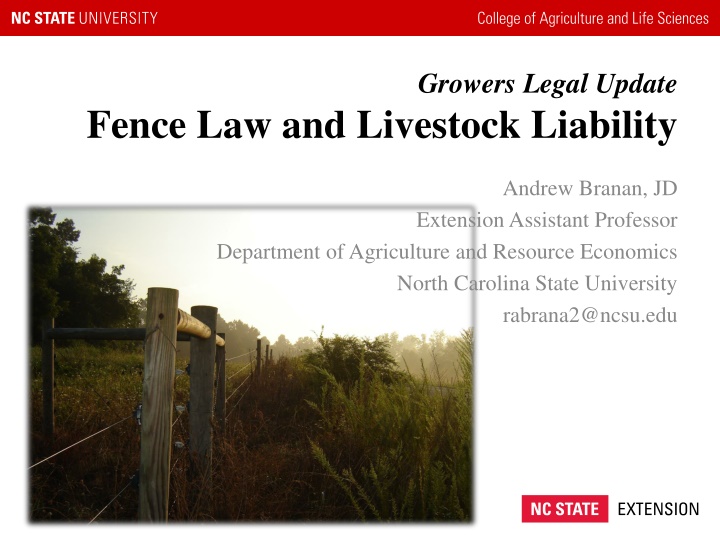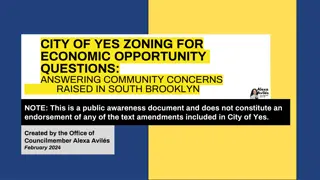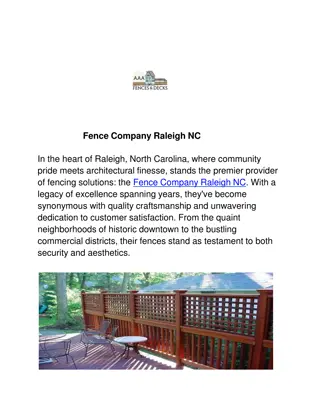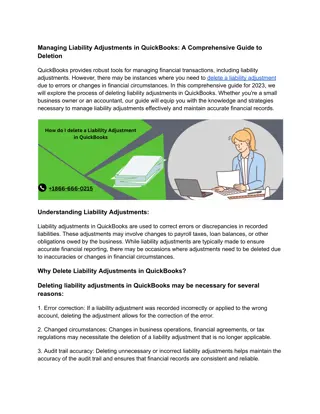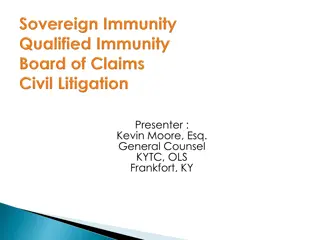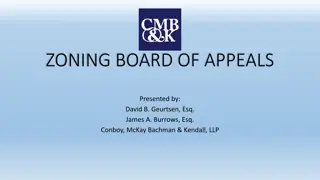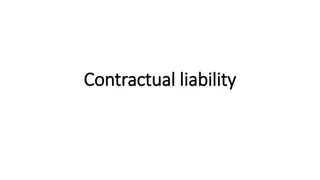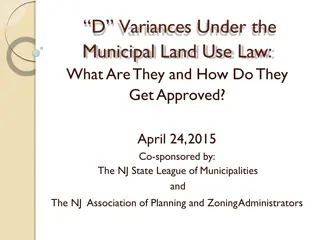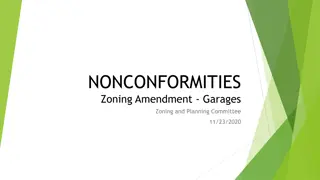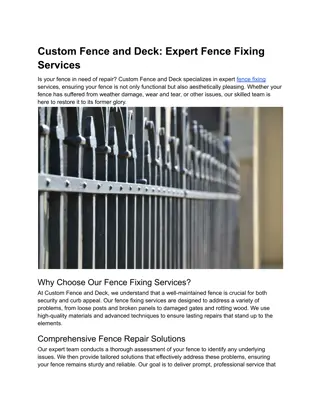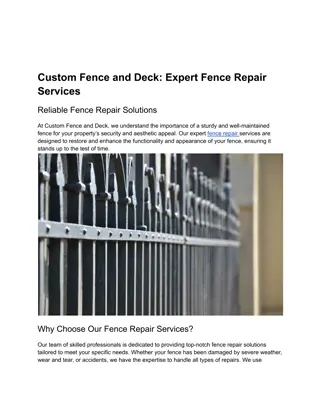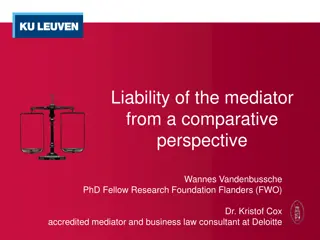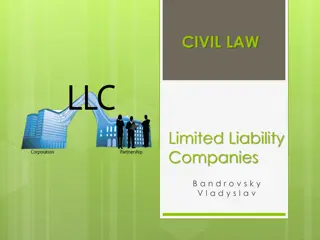Legal Update on Fence Law, Livestock Liability, and Zoning Regulations
Understanding the legal aspects of fence laws, livestock liability, and zoning regulations is crucial for growers and farmers. This update covers key points such as personal liability limits, compliance with exemptions, and the implications of livestock escaping. It also delves into boundary fencing requirements, definitions of livestock, and procedures for abandonment and impoundment under North Carolina law.
Download Presentation

Please find below an Image/Link to download the presentation.
The content on the website is provided AS IS for your information and personal use only. It may not be sold, licensed, or shared on other websites without obtaining consent from the author.If you encounter any issues during the download, it is possible that the publisher has removed the file from their server.
You are allowed to download the files provided on this website for personal or commercial use, subject to the condition that they are used lawfully. All files are the property of their respective owners.
The content on the website is provided AS IS for your information and personal use only. It may not be sold, licensed, or shared on other websites without obtaining consent from the author.
E N D
Presentation Transcript
Growers Legal Update Fence Law and Livestock Liability Andrew Branan, JD Extension Assistant Professor Department of Agriculture and Resource Economics North Carolina State University rabrana2@ncsu.edu
Anyone can get sued Insurance defends injury claims (assuming they are covered) Without insurance, must defend from your own pocket Goal is to follow system that will result in dismissal Limits on personal liability Compliance with statutory exemptions Document document document Most threats to sue do not materialize in a filed complaint (but notify insurer if claim of property damage or injury) Anything can happen in a courtroom, particularly with a jury Most applicable NC law is court-made Opinions published by Appellate and Supreme Courts (Superior Court verdicts do not carry weight of law) Settled case law is sparse
Fact Pattern (actual farmer call) Calf escapes through unbroken hot 4 strand poly fence once Neighbors call animal control who investigate fence and issue warning Calf escapes through same unbroken fence again Animal control, repeat Calf escapes through same unbroken fence again Animal control, repeat Farm qualifies for zoning as Bona Fide Farm Farm is a qualified farm in an Voluntary Agricultural District
Boundary Fencing Requirement Implied NCGS 68-15 et seq. Livestock Law Livestock defined: Include but not limited to equine animals, bovine animals, sheep, goats, llamas, and swine (NCGS 68-15) If any person shall allow his livestock to run at large, he shall be guilty of a Class 3 misdemeanor. (NCGS 68- 16) Loose Poultry: If any person shall permit any turkeys, geese, chickens, ducks or other domestic fowls to run at large on the lands of any other person while such lands are under cultivation in any kind of grain or feedstuff or while being used for gardens or ornamental purposes, after having received actual or constructive notice of such running at large, the person is guilty of a Class 3 misdemeanor. (NCGS 68-25)
Abandonment and Impoundment Owner guilty of Class 2 Misdemeanor for willful abandonment (N.C.G.S. 14-361.1) Any person may impound stray cattle Due reasonable costs of impoundment Owner known: must contact Owner unknown: inform Sheriff of details Animal deemed abandoned when: it is placed in the custody of any other person for treatment, boarding, or care; and the owner of the livestock does not retake custody of the animal within two months after the last day the owner paid a fee to the custodian for the treatment, boarding, or care of the livestock; and the custodian has made reasonable attempts to collect any past- due fees during the two-month period. May sell or dispose after 2 months
Escaped Livestock Liability - Civil Not Strict Liability Liability is based on Negligence standard ( reasonable and prudent ) A fact-based inquiry by court Cases: If an animal is repeatedly found running at large, the consent and knowledge of the owner may be inferred. Kelly v. Willis, 238 N.C. 637, 78 S.E.2d 711 (1953) It is the legal duty of a person having charge of animals to exercise ordinary care and the foresight of a prudent person in keeping them in restraint. Gardner v. Black, 217 N.C. 573, 9 S.E.2d 10 (1940) Evidence showed that the defendant property owner had removed barbed wire from his fencing with the intention of later replacing it with electrified wire, but never did the installation... issues of fact remained as to whether he exercised ordinary care and the foresight of a prudent person in keeping the horse in restraint because the horses were, in fact, able to push over the fence (no prior escapes therefore irrelevant) Bynum v. Whitley, 656 S.E.2d 16 (N.C. App. 2008)
Negligence Standard Escaped Livestock Liability rests upon the question whether the keeper is guilty (sic) of negligence in permitting them to escape. Legal duty standard is ordinary care and the foresight of a prudent person in keeping them in restraint. [P]laintiff must present evidence sufficient to indicate that defendant's animals were at large with his knowledge and consent, or at his will, or that their escape was due to any negligence on his part. Wilmoth v. Hemric, 768 S.E.2d 570 (N.C. App., 2014) Evidence examples failure to maintain an adequate fence Repeated citations leaving a gate open counting the cows too infrequently Other?
Fence Construction Can build fence inside but not on property line Becomes an encroachment Neighbor has remedy of ouster Can only repair fence from your side without trespass If neighbor connects to your fence, then trespass Survey recommended (not cheap) May have benefit of neighbor survey (research for recorded plat) Shared Fence with Neighbor by Agreement Joint construction and maintenance agreement Not enforceable against future owner unless recorded with County Register of Deeds
Note on Gates Many tracts of land have access to a public right of way via an easement Generally, the owner (A) of the servient estate (the land over which the easement runs) may erect a gate so long as it does not unreasonably interfere with the owner (B) of the dominant estate s use of the easement i.e. erect a gate and give party a code or key However, if instrument creating the easement (deed or other document) requires that the easement remain open , A may not install a gate. Holding of Taylor v. Adkins (June 2019)
Fence Removal Liability NCGS 14-144 Your land or land in dispute? [unlawful to] willfully burn, destroy, pull down, injure or remove any fence, wall or other enclosure, or any part thereof, surrounding or about any yard, garden, cultivated field or pasture Damage < $5000 = Class 2 Misdemeanor Damage > $5000 = Class 1 Felony Storm Damage Generally (Tree or limb fall) Reasonably foreseeable standard on owner of tree Can remove branches up to property line
Injury Liability Mosaic (and NC) Law "If an ox gore a man or a woman that they die; then the ox shall be surely stoned and his flesh shall not be eaten, but the owner of the ox shall be quit. But if the ox were wont to push with his horn in time past, and it hath been testified to his owner, and he hath not kept him in, but that he hath killed a man or a woman; the ox shall be stoned, and his owner also shall be put to death. If there be laid on him a sum of money, then he shall give for the ransom of his life whatsoever is laid upon him." (Exodus 21:28-30) - Banks v. Maxwell, 205 N.C. 233, 171 S.E. 70 (N.C., 1933)
Injury by Animals On-farm Standards of Duty Trespasser = no duty (exceptions) Invitee = negligence standard Liability Immunity by Statute (NCGS 99E-7) Warns of inherent risk must plead the affirmative defense of assumption of the risk of the farm animal activity Agritourism, rodeos, training, boarding, veternarians Must post signage (language in statute) Does not cover products liability
99E-6[9]) Inherent Risk Defined ( The possibility of a farm animal behaving in ways that may result in injury, harm, or death to persons on or around them. The unpredictability of a farm animal's reaction to such things as sounds, sudden movement, unfamiliar objects, persons, or other animals. The risk of contracting an illness due to coming into physical contact with animals, animal feed, animal waste, or surfaces that have been in contact with animal waste. Inherent risks of farm animal activities does not include a collision or accident involving a motor vehicle.
Exceptions to 99E Liability Limitation (Equine) (1) Provides the equipment or tack, and knew or should have known that the equipment or tack was faulty, and such faulty equipment or tack proximately caused the injury, damage, or death. or (2) Provides the equine [or farm animal] and failed to make reasonable and prudent efforts to determine the ability of the participant to engage safely in the equine activity or to safely manage the particular equine. or (3) Commits an act or omission that constitutes willful or wanton disregard for the safety of the participant, and that act or omission proximately caused the injury, damage, or death.
Signage Required The signs shall be placed in a clearly visible location on or near stables, corrals, arenas, or other farm animal facilities where the farm animal professional or the farm animal activity sponsor conducts animal activities. "WARNING Under North Carolina law, a farm animal activity sponsor or farm animal professional is not liable for an injury to or the death of a participant in farm animal activities resulting exclusively from the inherent risks of farm animal activities. Chapter 99E of the North Carolina General Statutes."
Trespass 38B-2. General rule. A possessor of land, including an owner, lessee, or other occupant, does not owe a duty of care to a trespasser and is not subject to liability for any injury to a trespasser. 38B-3. Exceptions Intentional harm = willful or wanton Example: thin wire across field entrance (to repel ATV) May use reasonable force to repel a crime Harm to Children (<14) (attractive nuisance doctrine) reason to know that children were likely to trespass and owner knew of unreasonable risk of serious bodily injury or death and child did not appreciate the risk and utility to the possessor of maintaining the condition and the burden of eliminating the danger were slight as compared with the risk discover the condition or realize the risk involved and possessor failed to exercise reasonable care to eliminate the danger or otherwise protect the injured child.
Livestock Injury to Trespasser "The animal inflicting the injury must be dangerous, vicious, mischievous or ferocious, or one termed in the law as possessing a vicious propensity." and "The owner must have actual or constructive knowledge of the vicious propensity, character and habits of the animal. Rector v. Southern Coal Co, 192 N.C. 804, 136 S.E. 113 (N.C., 1926) The propensity is vicious if it tends to harm, whether manifested in play or in anger, or in some outbreak of untrained nature Hill v. Moseley Et Ux, 220 N.C. 485, 17 S.E.2d 676 (N.C., 1941)
Liability Standards and Evidence (On Farm Injury) Owner or keeper of vicious animal has strict liability Swain v. Tillett, 269 N.C. 46, 152 S.E.2d 297 (1967) Landlord for tenant owner of vicious animal may be found negligent Holcomb v. Colonial Associates, LLC, 597 S.E.2d 710, 358 N.C. 501 (N.C., 2004) Lease clause requiring removal infers landlord control The prior behavior of an animal is admissible to show both the animal's vicious propensities and the owner's actual or constructive knowledge of such propensities, even though the behavior falls short of actual injury. [T]he animal's reputation, while inadmissible to show directly the animal's vicious propensities, is admissible to show the owner's knowledge of the alleged propensity and to corroborate the testimony of those who have sworn to the animal's viciousness. Williams v. Tysinger, 388 S.E.2d 616, 97 N.C.App. 438 (N.C. App., 1990)
Nuisance Scenario: Plan to take a loan to build a chicken house, neighbor objects, threatens to sue Must unreasonably interfere with neighbor s use and quiet enjoyment Right to Farm Law 2018 updated standing and damages Not applicable to negligence, trespass, personal injury, strict liability, other torts Mandatory Mediation (NCGS 7A-38.3) Pre-litigation requirement unless waived Voluntary Agriculture District (2018 update) 1000 feet poultry, swine or dairy 600 feet of qualifying farm mile from VAD
New Right to Farm (106 (all must apply) 701) 106- -701 (1) The plaintiff is a legal possessor of the real property affected by the conditions alleged to be a nuisance. (2) The real property affected by the conditions alleged to be a nuisance is located within one half-mile of the source of the activity or structure alleged to be a nuisance. (3) The action is filed within one year of the establishment of the agricultural or forestry operation or within one year of the operation undergoing a fundamental change.
Fundamental Change is not: A change in ownership or size. An interruption of farming for a period of no more than three years. Participation in a government-sponsored agricultural program. Employment of new technology. A change in the type of agricultural or forestry product produced. Grazing cattle to poultry house? Forestry harvest cleared for poultry house?
Nuisance Damages ( 106-702) measured by the reduction in the fair market value of the plaintiff's property caused by the nuisance, but not to exceed the fair market value of the property (new) A plaintiff may not recover punitive damages from an agricultural or forestry operation that has not been subject to a criminal conviction or a civil enforcement action taken by a State or federal environmental regulatory agency pursuant to a notice of violation for the conduct alleged to be the source of the nuisance within the three years prior to the first act on which the nuisance action is based.
Animal Activism: Drone Law Any person who is the subject of unwarranted surveillance, or whose photograph is taken in violation of the provisions of this section, shall have a civil cause of action If you hear a drone you think is trying to take evidence on your property, go outside and make sure it is taking a picture of you! In lieu of actual damages, the person whose photograph is taken may elect to recover five thousand dollars ($5,000) for each photograph or video that is published or otherwise disseminated, as well as reasonable costs and attorneys' fees and injunctive or other relief as determined by the court.
Drone Law ( 15A-300.1) Surveillance of real property prohibited without consent of owner or lessee ( 15A-300.1[b][1][b]) May not photograph an individual, without the individual's consent, for the purpose of publishing or otherwise publicly disseminating the photograph. Does not apply to newsgathering, newsworthy events, or events or places to which the general public is invited Maximum height: 400 feet Permit for commercial operation 18 U.S.C. 32 prohibits destruction of aircraft Cannot use to hunt or fish or interfere with taking of wildlife
Animal Activism: NC Ag Gag law Creates a civil right of action for private employers North Carolina Property Protection Act, N.C.G.S. 99E-2(b) Employee enters non-public space of employment to remove or capture data, paper, records, or any other documents and uses the information to breach the person's duty of loyalty to the employer records images or sound occurring within an employer's premises placing on the employer's premises an unattended camera or electronic surveillance device Commits An act that substantially interferes with the ownership or possession of real property Under challenge in PETA v. Stein (before federal Middle District NC, 1:16-cv-00025-TDS-JEP ) 4thCircuit has granted standing to PETA et al in pre-enforcement challenge to First Amendment rights Ag Gag law declared unconstitutional in Iowa Federalism implications with recent Preventing Animal Cruelty and Torture Act (PACT) law
Bona Fide Farm Status - Zoning Exemption from County zoning restrictions Not an exemption from NC Building Code requirements New statute all but requires issuing permit for all farm buildings Safe Harbors NCGS 153A-340 A farm sales tax exemption certificate issued by the Department of Revenue. A copy of the property tax listing showing that the property is eligible for participation in the present use value program pursuant to G.S. 105-277.3. A copy of the farm owner's or operator's Schedule F from the owner's or operator's most recent federal income tax return. A forest management plan FSA Farm Numbers no longer qualify
Bona Fide Farm - Agritourism A building or structure that is used for agritourism is a bona fide farm purpose if the building or structure is located on a property that (i) is owned by a person who holds a qualifying farmer sales tax exemption certificate from the Department of Revenue pursuant to G.S. 105-164.13E(a) or (ii) is enrolled in the present-use value program pursuant to G.S. 105-277.3. Failure to maintain the requirements of this subsection for a period of three years after the date the building or structure was originally classified as a bona fide purpose pursuant to this subdivision shall subject the building or structure to applicable zoning and development regulation ordinances adopted by a county pursuant to subsection (a) of this section in effect on the date the property no longer meets the requirements of this subsection. For purposes of this section, "agritourism" means any activity carried out on a farm or ranch that allows members of the general public, for recreational, entertainment, or educational purposes, to view or enjoy rural activities, including farming, ranching, historic, cultural, harvest-your-own activities, or natural activities and attractions. A building or structure used for agritourism includes any building or structure used for public or private events, including, but not limited to, weddings, receptions, meetings, demonstrations of farm activities, meals, and other events that are taking place on the farm because of its farm or rural setting.
THANKS FOR INVITING ME! Robert Andrew Branan Assistant Extension Professor Department of Agriculture and Resource Economics North Carolina State University Campus Box 8109 4336 Nelson Hall Raleigh, NC 27695 rabrana2@ncsu.edu 919 515 4670
